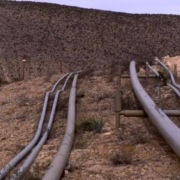Food and Agriculture in a Steady State Economy
by Brent Blackwelder
The annual book festival of the Library of Congress just featured Jonathan Safran Foer who spoke about his book Eating Animals. He writes about his grandmother who survived World War II on the run from the Germans, scavenging from garbage cans and always on the verge of starvation. However, she refused to eat a piece of pork given her by a kindly farmer because “if nothing matters, nothing is worth saving.”
This fall (what better time than harvest season?), I will focus my Daly News essays on the ethics and policies that would characterize food production in a steady state economy. These essays will offer answers to questions such as: What would people eat and how would it be grown? Would almost everyone be a vegetarian or vegan? Would genetically engineered food play a big role? What about farm subsidies and the role of biofuels? How many of the current agricultural practices in the United States would even continue as part of a steady state economy?
Since sustainable scale is the most important feature of a steady state economy (i.e., the economy must fit within the capacity of the ecosystems that contain it), the first issue to investigate is how environmental systems are responding to agricultural practices – in particular, the effects of agricultural practices on climate. There is growing evidence that animal agriculture is the number one cause of global climate destabilization, contributing more than all global transport put together. Former World Bank ecologist Robert Goodland has produced an analysis showing that at least half of the human-caused greenhouse gases come from the production of domesticated animals. Livestock and their byproducts account for over 32.5 billion tons of carbon dioxide a year, or roughly 51% of annual worldwide greenhouse gases (see Worldwatch Nov./Dec. 2009).
Here is the unsettling irony: factory-farm dominated agriculture, as a major climate destabilizer, is creating long-term weather changes that compromise the ability of the earth to produce food.
Plant ecologists estimate that for every 1 degree Celsius temperature increase, grain yields drop 10%. Climate disruption has led to serious melting of snowpacks and glaciers in most places. In the Western U.S. where snowpacks store about 75% of the water supply, the Natural Resources Defense Council reports that climate change could reduce this to 40% by 2060. Similar concerns exist for the great Asian rivers like the Ganges and the Mekong that originate in the Tibetan plateau.
These impacts are not being imposed on a planet whose soils and grasslands are in wonderful condition and whose groundwater has been safeguarded and not pumped beyond recharge. These impacts are not being imposed on a planet whose human population has stabilized but rather is likely to reach 9-11 billion by 2050.
In contrast to this grim picture of the agricultural capacity of the planet, many encouraging trends in food production are emerging. Examples include growth of organic food consumption, expansion of farmers markets, the local food movement, the slow food movement, the food-miles movement, and initiatives to get healthy food into schools – all of which are heading in promising directions.
A steady state economy would bolster these trends. It would move away from control of food by transnational corporations and toward an increased number and diversity of small and medium-sized farms, and healthy rural communities. Revamped agricultural systems would provide many varieties of food in ways that conserve soil and water and maintain long-term fertility of the land.
These promising developments are taking place not because of, but in spite of, the U.S. Department of Agriculture, which has for the most part been a giant promoter of animal slum operations and presider over the demise of the family farm.
Over 10 million animals are slaughtered for food each year in the U.S. in factory slum operations that produce over 95% of the nation’s meat. It is abundantly clear that meat-dominated megafarm agriculture is not sustainable (even from the climate/energy standpoint alone), and it could not be part of the food system in a steady state economy.
A steady state economy would not feature perverse subsidies as a cornerstone of the economy. Yet in the U.S. a curious mathematical formula governs the dispensing of subsidies: the more environmentally damaging and harmful to public health the practice or project, the larger the state and federal handouts.
Thus, industrial agriculture enjoys all sorts of subsidies from the Farm Bill. Its extensive use of energy-intensive pesticides and fertilizers is supported by the numerous subsidies the fossil fuel industry receives. Gigantic animal factory slums not only get subsidized, but they externalize their environmental and health costs onto their neighbors and the public. Time magazine documented the competition among states to see who could dole out the most tax money to lure one of these animal slum operations into their state. In contrast, the encouraging trends in agriculture that I cited receive very little governmental support.
Note: CASSE also has a briefing paper on the topic of agriculture in a steady state economy.





http://www.theecologist.org/News/news_analysis/604208/uk_farmers_face_dilemma_over_superdairy_plans.html
This link shows what might happen here in the UK.
Opposition is increasing but this trend is very worrying. Profit and growth in the driving seat, as always.
For more on food, including climate change impact on protein, why farmers need a pay raise, and a book review on food by a cool kid, see:
http://8020vision.com/category/global-challenges/food/
How about Europe? Is the same happening in Europe?
family farms, local farmer’s markets etc. have to involve many more people with smaller profit margins, so they don’t have the time or resources to court or buy politicians to give them a larger piece of the subsidies. Just heard a piece on NPR about how the fossil fuel subsidies are 100 years old, started to foster exploration, yet we can’t get support to shift even some of that into new renewable energy. Forget about subsidizing smaller farms, sad to say.
I agree entirely with the general direction of this article but don’t think there is sufficient evidence to show that organic agriculture, as it is currently practiced and accredited, will necessarily be enough to feed a larger population. Yet industrial agriculture as it is practiced now is a recipe for disaster. What we need is a hybrid system that takes advantaged of both organic systems, in which the health of the soil ecology is further improved, and GM technologies that can be geared to organic systems – the two are not necessarily mutually exclusive. To be fully against GM is a bit like being fully against (for example) metalurgy on the basis that guns are made of metal; in other words, we should not rule out any technological system but should assess how the best aspects of each technology might be combined or become symbiotic.
I also support the localisation of food systems and economic structures but, by the same token of using the best of all available technologies, we should also be aware that many localised food systems are as wasteful of energy and resources as some ‘big ag’ systems. Every time we look at replacing one technology with another, we need to do cradle-to-grave energy and impact assessments. Herman Daly’s economic vision can only be improved by science-based research and what is true for one technology in one climate or geographical area might not be true elsewhere.
http://www.sirisuk.org
You must mean “mammals” rather than “animals”. 23 million chickens alone are slaughtered in the United States EACH DAY… (USDA numbers)–18 billion a year…
In re: “Steady State Economy”:
Universal Platform for Developing Sustainable Earth “Vision” Co-operatively.
http://www.modelearth.org/seed.html
Thank you, Hearthstone.
I think it is worth adding that the vast majority of that chicken and beef is going to one industry. Fast food. To many local governments (mine included) don’t see, or refuse to see the destruction this industry has wrought upon this earth and its population.
If you ponder on the issue, I would tend to think that it boils to Education (more informal than formal, less classroom and more thinking) if the consumers still buy fast food junck instead of grass-fed, it doesn’t matter where the subsidies go. Needless to say, CAFO meat production is in a bind with the increased price on grain, thanks biofuels. But will it stop without the incentives of wise consumers ??